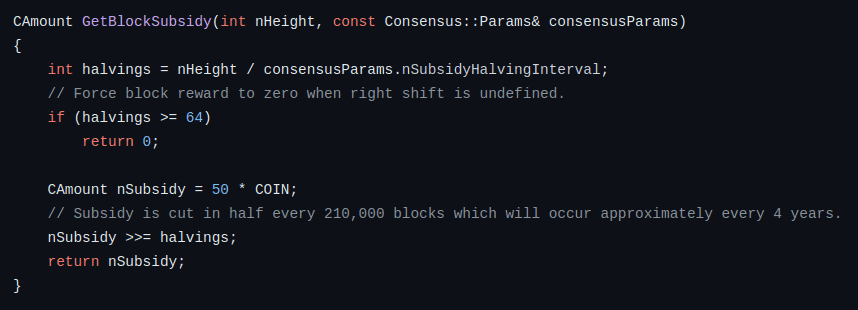How Many Bitcoins Are There?
What Happens After All 21 Million Bitcoins Are Mined?
One of the biggest reasons Bitcoin is the best Store Of Value is that it’s the only one that has provable, finite scarcity. There will never be more than 21 million bitcoin or 21 quadrillion Satoshi. This is because it’s written into the Bitcoin Core code and will never be changed.
After all 21 million bitcoins have been mined, the minting of new bitcoins will stop and miners will only earn income from the transaction fees inside each block.
The Bitcoin Halving (also called Bitcoin Halvening) is when the block subsidy that’s rewarded to Bitcoin miners is halved. Currently the block subsidy is 3.125 BTC, but it will reduce to 1.5625 BTC in the next bitcoin halving.
Below are the historic and future Bitcoin halvings. As you can see, they occur every 210,000 blocks and will continue until around 2140 which will be the last Bitcoin halving. After this, the Block Subsidy will be reduced to 0 BTC and the bitcoin Block Rewards will be entirely made up of just transaction fees.
| Halving | Era | Block Height | Block Subsidy | Date |
|---|---|---|---|---|
| 2009 | 0 (Genesis Block) | 50.00000000 BTC | 3rd Jan, 2009 | |
| 1 | 2012 | 210,000 | 25.00000000 BTC | 28th Nov, 2012 |
| 2 | 2016 | 420,000 | 12.50000000 BTC | 9th Jul, 2016 |
| 3 | 2020 | 630,000 | 6.25000000 BTC | 11th May, 2020 |
| 4 | 2024 | 840,000 | 3.12500000 BTC | 20th Apr, 2024 |
| 5 | 2028 (est) | 1,050,000 | 1.56250000 BTC | |
| 6 | 2032 (est) | 1,260,000 | 0.78125000 BTC | |
| 7 | 2036 (est) | 1,470,000 | 0.39062500 BTC | |
| 8 | 2040 (est) | 1,680,000 | 0.19531250 BTC | |
| 9 | 2044 (est) | 1,890,000 | 0.09765625 BTC | |
| 10 | 2048 (est) | 2,100,000 | 0.04882813 BTC | |
| 11 | 2052 (est) | 2,310,000 | 0.02441406 BTC | |
| 12 | 2056 (est) | 2,520,000 | 0.01220703 BTC | |
| 13 | 2060 (est) | 2,730,000 | 0.00610352 BTC | |
| 14 | 2064 (est) | 2,940,000 | 0.00305176 BTC | |
| 15 | 2068 (est) | 3,150,000 | 0.00152588 BTC | |
| 16 | 2072 (est) | 3,360,000 | 0.00076294 BTC | |
| 17 | 2076 (est) | 3,570,000 | 0.00038147 BTC | |
| 18 | 2080 (est) | 3,780,000 | 0.00019073 BTC | |
| 19 | 2084 (est) | 3,990,000 | 0.00009537 BTC | |
| 20 | 2088 (est) | 4,200,000 | 0.00004768 BTC | |
| 21 | 2092 (est) | 4,410,000 | 0.00002384 BTC | |
| 22 | 2096 (est) | 4,620,000 | 0.00001192 BTC | |
| 23 | 2100 (est) | 4,830,000 | 0.00000596 BTC | |
| 24 | 2104 (est) | 5,040,000 | 0.00000298 BTC | |
| 25 | 2108 (est) | 5,250,000 | 0.00000149 BTC | |
| 26 | 2112 (est) | 5,460,000 | 0.00000075 BTC | |
| 27 | 2116 (est) | 5,670,000 | 0.00000037 BTC | |
| 28 | 2120 (est) | 5,880,000 | 0.00000019 BTC | |
| 29 | 2124 (est) | 6,090,000 | 0.00000009 BTC | |
| 30 | 2128 (est) | 6,300,000 | 0.00000005 BTC | |
| 31 | 2132 (est) | 6,510,000 | 0.00000002 BTC | |
| 32 | 2136 (est) | 6,720,000 | 0.00000001 BTC | |
| 33 | 2140 onward | 6,930,000 onward | 0.00000000 BTC |
How Is The 21 Million Bitcoin Supply Limit Enforced?
Interestingly, there is no actual “21 million supply limit” in the Bitcoin Core code. Instead, the total supply of bitcoin is limited to just under 21 million bitcoins by just 6 lines of code shown below that calculates the block subsidy. This Bitcoin Core code is located in the “validation.cpp” file under bitcoin/src/.
What it does is figure out how many Bitcoin Halving events have happened, then calculates the size of the block subsidy that’s given to miners for that block. Currently there have been 3 halvings and the block subsidy is 3.125 BTC. Due to this specific code, there will only ever be a total of 33 halvings.

We can also easily use it to calculate the exact amount of bitcoin mined every day, for the rest of all time. As a result, the total bitcoin supply is simply the sum of all these mined bitcoins. The only way to increase the number of bitcoins would be to change this code, which would be fiercely opposed by virtually all bitcoin holders.
How The Code Works
To fully verify and understand why there are the amount of bitcoins there are, we’re going to go through this important bit of code line by line. It’ll help if you’ve done programming before, but hopefully we can explain it simply enough even if you haven’t. Let’s look at some of the values:
- nHeight: The current blockchain height, eg 850,000
- nSubsidyHalvingInterval: The number of blocks between each halving, which is 210,000
- COIN: A global constant, 100,000,000 which is the number of Satoshis per bitcoin
- nSubsidy: The calculated block subsidy that this function returns
In the first line, the number of halvings is calculated by dividing the current block height (nHeight) of the Bitcoin Blockchain by the halving interval (nSubsidyHalvingInterval) or 210,000. If the current block height is 850,000 this gives us:
850,000 / 210,000 = 4.047619048
As the variable is an “int” or integer, it drops all the decimal places simply leaving the answer as 4. It then calculates the block subsidy (nSubsidy) on lines 1675 and 1677 by taking the starting block subsidy value (50 BTC) and converting it into Satoshis by multiplying it by COIN (100,000,000).
50 * 100,000,000 = 5,000,000,000
Finally it then divides it in half over and over again using the bitwise operator on line 1677. This divides it in half by the number of halvings that was just calculated above, so four times:
5,000,000,000 / 2 / 2 / 2 / 2 = 312,500,000 Satoshi = 3.125 BTC
As the bitcoin block height increases over time, the block subsidy gets cut in half more and more. Eventually it reaches the limit of decimal places (8) and we go from a block subsidy of 1 Satoshi (0.00000001 BTC) to 0 Satoshi, as the code does not allow for fractions of a Satoshi to exist.
How Many Bitcoins Are There Lost Forever?
There is no exact way to know how many lost coins there are. This is because coins stored in a wallet address could be lost forever or inaccessible, but no one would know. To an outside observer they would just appear to be staying put in their wallet forever.
Lost coins only make everyone else’s coins worth slightly more. Think of it as a donation to everyone.
Satoshi Nakamoto
Most estimates conclude that there are around 3-4 million lost bitcoins that will never be recovered or moved with some of the top ones being:
- Satoshi Nakamoto: Creator of Bitcoin, Satoshi Nakamoto was the first to mine bitcoin resulting in an enormous stash of over 1.1 million bitcoins. While it’s unknown if they still have access to these funds, none have ever moved since they were first mined
- Individual X: Believed to be a thief that stole 69,000 bitcoin from the infamous Silk Road black market website, Individual X is apparently known to the US government
- James Howells: After acquiring 7,500 bitcoin James stored his bitcoin wallet on an old laptop hard drive which he then accidentally discarded in 2013. It’s now somewhere in the Welsh town landfill, burred forever
- Stefan Thomas: Buying 7,002 bitcoin way back in 2011, Stefan stored his bitcoin wallet on a Kingston IronKey USB drive and then promptly forgot the password. With only 10 attempts to guess it, no one has been able to recover the funds so far
What Happens to Mining Fees When Bitcoin’s Supply Limit Is Reached?
The Block Reward is paid out to miners that successfully add new, valid bitcoin blocks to the Bitcoin Blockchain and is made up of two parts:
Block Reward = Block Subsidy + Transaction Fees.
The Block Subsidy is freshly minted bitcoins that are added to the network as part of the block reward for miners doing Proof-of-Work (PoW). The transaction fees are just what people are paying to have their transactions included in the block and are already existing bitcoins.
When Bitcoin first started, the Block Subsidy was 50 BTC. Each time someone mined a new block, they would get all the transaction fees and the ability to spend 50 new bitcoins. As you can see, this is a huge incentive and a much bigger block reward than what miners get now, which is only 3.125 BTC.
While it’s true that once the limited supply of bitcoin is reached miners won’t receive any more block subsidies, this is far off into the future. It’s also estimated that the transaction processing fees will have long taken over as the main source of mining rewards before this 2140 date is reached.
The bitcoin mining industry is already getting more and more of the mining reward from bitcoin transaction fees and this is seen as a healthy thing for the bitcoin ecosystem in general. As the number of bitcoins created decreases, it’s also likely that it will increase bitcoin’s price too. This will mean that these relatively smaller fees will become more and more valuable over time.
Can Bitcoin’s Supply Cap Be Changed?
The short answer is no.
While anyone is free to copy and change the Bitcoin Core code, it would only be considered “the real Bitcoin” if the hundreds of thousands of full Bitcoin Nodes and Bitcoin Miners made the conscious decision to manually update their software to it.
A great way to explain this is with Chess. Imagine that you didn’t like the rules of chess for some reason, so you created a new Chess 2.0. Chess has been played with the same basic rules for thousands of years all over the world. You’re free to create Chess 2.0, but it’s not going to change how everyone else plays the game.
Similarly, anyone is free to change the Bitcoin Core code to have any maximum supply they want. But there would be no reason for anyone to use this new code as it would dilute the value of their bitcoin holdings and they’re happy using the current Bitcoin network.
To truly change Bitcoin’s total supply, a Hard Fork update to Bitcoin Core would need to be manually and consciously installed on the overwhelming majority of the hundreds of thousands of privately owned Bitcoin nodes all around the world. As you can imagine, this is never going to happen.
FAQ
Who Owns The Most Bitcoin?
Creator of Bitcoin, Satoshi Nakamoto was the first to mine bitcoin resulting in an enormous stash of over 1.1 million bitcoins. While it’s unknown if they still have access to these funds, none have ever moved since they were first mined
How Much Bitcoin Is Mined Per Day?
Currently the bitcoin subsidy is 3.125 bitcoin. This means that the number of bitcoins minted in each block is 3.125, with each block being mined on average every 10 minutes. If we assume there are 6 x 24 = 144 blocks mined per day, that means there is on average 3.125 BTC x 144 blocks = 450 bitcoins mined per day.
How Many Bitcoins Are Left To Mine?
After the 4th halving, that occurred on the 20th April, 2024, there will only be 1,312,499.998 bitcoin left to mine. This represents just 6.25% of all the bitcoins that will ever be mined.
Will We Run Out Of Bitcoin To Mine?
Yes. In roughly the year 2140, the last fraction of a bitcoin will be mined for the bitcoin network. At this point, although there will be no more bitcoins minted in each new block, the mining process will still earn revenue due to transaction fees that people will pay to have their bitcoin transaction included in the next block.


